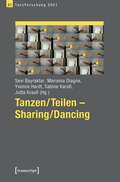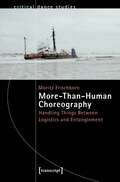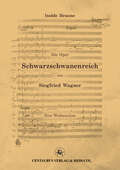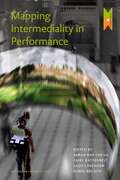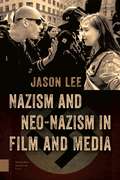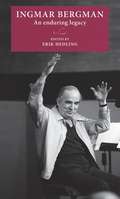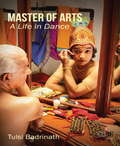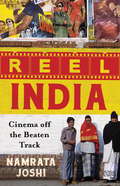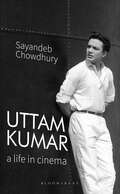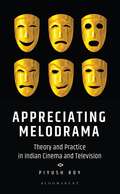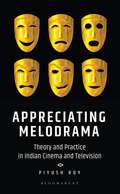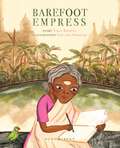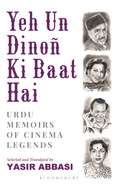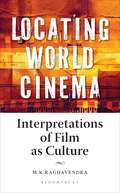- Table View
- List View
Tanzen/Teilen - Sharing/Dancing: Jahrbuch TanzForschung 2021 (TanzForschung #31)
by Sevi Bayraktar Mariama Diagne Yvonne Hardt Sabine Karoß Jutta KraußIm Teilen verbirgt sich eine Doppelbedeutung: mitteilen und teilhaben, aber auch zerteilen, Differenzen erfahren. Welche Bedeutung hat das Teilen für die tänzerische Praxis? Welche Formen des Tanzes treten dabei hervor? Und welche Zugänge des Teilens wurden in Online-Formaten entwickelt? Pandemien und Kriege verdeutlichen, wie Gesellschaften mit eingeschränktem körperlichem Miteinander und verringertem Bewegungsradius starre Formen des Teilens aufzeigen. Die Beitragenden des Bandes betrachten Ausschlusspraktiken und untersuchen das Teilen aus intersektionalen Perspektiven, um (Un-)Möglichkeiten des In-Kontakt-Tretens von Kunstschaffenden, Forschenden und Zuschauenden zu entwerfen.
Tanzen als Widerstand: »One Billion Rising« und choreographische Interventionen im öffentlichen Raum (TanzScripte #64)
by Kristina Stein-Hinrichsen»Strike. Dance. Rise!« lautet der Appell und das Versprechen der feministischen Kampagne »One Billion Rising«. Zum ersten Mal in der Geschichte der Demokratien stehen weibliche Körper und die ästhetische Bewegungspraxis Tanz als Mittel und Botschaft im Zentrum eines transnationalen zivilgesellschaftlichen Protests. Kristina Stein-Hinrichsen erforscht in ihrer kulturvergleichenden Studie, ob und unter welchen Bedingungen Tanz ein wirksames Medium der Demonstration sein kann. Dabei folgt sie einem performativen Verständnis von Öffentlichkeit, Geschlecht und Choreographie und erweitert die Forschung zu den globalen sozialen Bewegungen um die körperliche Dimension von Protest.
More-Than-Human Choreography: Handling Things Between Logistics and Entanglement (TanzScripte #65)
by Moritz FrischkornIn the global context of the Great Acceleration, things and people have been on the move more than ever before. Moritz Frischkorn takes a fresh look at recent performing arts practices that deal with everyday objects on and beyond the stage. Contrasting these practices with the business field of logistics, he examines the aesthetic and ethical concerns of moving things. Drawing on concepts from performance as well as Black studies and philosophy, and based on an artistic-research methodology, the book formulates a notion of more-than-human choreography as an ecologically informed, infinitely indebted practice of living within the material world.
Grain & Noise - Artists in Synthetic Biology Labs: Constructive Disturbances of Art in Science (Image #221)
by Markus SchmidtThe collaboration between scientists and artists in the form of Artist-in-Lab residencies may not only cause a productive disturbance for a day's work in the laboratory, but also reveal new ways of understanding. Research and science communication company Biofaction has brought together artists and synthetic biologists throughout Europe in a residence program that spans four truly cross-disciplinary collaborations. The contributors to this volume share their reflections of the dynamic frictions that occurred when their artistic and scientific worlds met. These stories, where chemistry labs, tobacco plants, genetically edited bacteria, and new-to-nature enzymes collide with music, photography, film, and visual arts, infuse the ongoing dialogue between art and sciences with grain, noise, and synergies.
Wie kommt Tanz ins Museum?: Zur Tanzkunst im Ausstellungskontext bei Xavier Le Roy, Anne Teresa De Keersmaeker und Boris Charmatz (TanzScripte #67)
by Katharina de Andrade RuizTanz gewinnt aktuell an Relevanz im Ausstellungskontext. Tänzer*innen bewegen sich durch originär für Kunstobjekte geschaffene Säle, Choreograf*innen bespielen Museen und werden zu Ausstellungsgestalter*innen. Mit Blick auf das Beziehungsgeflecht von Tanz, bildender Kunst, Museum und Ausstellung von Beginn des 20. Jahrhunderts bis zur Gegenwart zeigt Katharina de Andrade Ruiz auf, wie die Tanzkunst in den Ausstellungskontext gelangt. Im Fokus ihrer Analyse stehen choreografische Arbeiten von Xavier Le Roy, Anne Teresa De Keersmaeker sowie Boris Charmatz, die als Beispiele für Live-Tanz-Ausstellungen, Fusionen von zeitgenössischer Tanzkunst und dem Präsentationsformat Ausstellung dienen.
Routinen im Tanz: Künstlerische Praktiken zwischen Stabilisierung und Destabilisierung. Jahrbuch TanzForschung 2022 (TanzForschung #32)
by Katja SchneiderGerade in der Kunst haben Routinen kein gutes Renommee: zu starr, zu einengend, zu langweilig - so zumindest die weit verbreitete These. Dabei sind sich die stabilisierenden Kräfte von Routinen und die innovative Instabilität künstlerischer Praxis näher als oft vermutet. Die Beiträger*innen widmen sich zum einen der produktiven Kraft und zum anderen den krisenhaften Momenten von eingeübten, gewohnheitsmäßigen Praktiken in Tanz und Performance. Dabei nehmen sie Routinen in der Ausbildung, in künstlerischer Praxis und Wissenschaft sowie im Kontext digitaler Formate und postkolonialer Ansätze in den Blick - und zeichnen so ein Bild des Tanzes im Spannungsfeld von Stabilisierung und Veränderung.
Choreophonien: Konstellationen von Stimme und Körper im Tanz der Moderne und der Gegenwart (TanzScripte #68)
by Julia OstwaldDie Stimme stellt eine konstitutive, aber vernachlässigte Kategorie im Denken über Tanz dar. Anhand von Fallstudien aus dem modernen und zeitgenössischen euroamerikanischen Bühnentanz untersucht Julia Ostwald diverse Stimm-Körper-Konstellationen, die kanonisierten Setzungen von Tanz als stummer Kunstform entgegenlaufen. Mithilfe der Denkfigur der Choreophonien analysiert sie spezifische Verschränkungen von ästhetischen Verfahren, sinnlichen Wahrnehmungen und ihren mikropolitischen Dimensionen. Somit erschließt sie ein tanzwissenschaftliches Forschungsfeld, das nicht nur Impulse für Theorie und Praxis der performativen Künste, sondern auch für die Gender und Queer Studies gibt.
Tanz und kulturelle Bildung erforschen: Eine Einführung (TanzScripte #69)
by Yvonne HardtTanz als körperlich-sinnliche Praxis boomt im Kontext kultureller Bildung: Neben Formaten wie Tanz in Schulen und Community Dance entstehen in informellen Settings und sozialen Medien immer neue Vermittlungsweisen. Doch wie lassen sich diese erforschen? Yvonne Hardt bietet anhand eines an zahlreichen Beispielen erläuterten Fragenkatalogs eine innovative Einführung in die Erforschung von Tanz und verbindet Praxeologie, Historiographie und Diskursanalyse. Anhand von Kategorien wie Bewegung, Aneignung, Irritation, Scheitern, Teilhabe u.a. schlüsselt sie das Feld kultureller Bildung und Tanz in seiner Komplexität auf - und fördert zugleich methodische Reflexionen über den Tanz hinaus.
Materialities in Dance and Performance: Writing, Documenting, Archiving (TanzScripte #70)
by Gabriele Klein Franz Anton CramerWhat is »materiality« in dance and performance? What role does »the material« play in the formation for the cultural memory of ephemeral arts? The contributors to this volume examine concepts of materiality in dance and performance, the use of materials in artistic practices and the role of social media in changing the perception of time-based artefacts. The volume shows how the focus on materiality transforms contemporary artistic work and challenges established concepts of dance and performance research.
The Bodies We Are: A Choreographic Research on Practicing Self-Distancing (TanzScripte #71)
by Antje VelsingerIn Western neo-liberal society, the human body is increasingly used as an »identity project« and »designable object«. Antje Velsinger investigates these specific roles of the body and develops choreographic strategies for becoming unfamiliar to the own self and play as two means for emancipating the body from the neo-liberal imperative of optimization and control. Theoretical and practical artistic perspectives are in constant dialogue throughout this study. It uses the choreographic field as a gray area between theory and practice to imagine, propose, and rehearse an alternative approach to the body.
Choreografischer Baukasten. Das Buch (TanzScripte #73)
by Gabriele KleinDer »Choreografische Baukasten« ist eine an der zeitgenössischen choreografischen Praxis orientierte ›Werkzeugkiste‹. Er entstand in Zusammenarbeit mit international renommierten Choreograf_innen, die Erfahrungen aus eigenen künstlerischen Projekten eingebracht haben. Der Baukasten präsentiert ein breites Spektrum zeitgenössischer choreografischer Arbeitsweisen und ist von der Idee geleitet, Möglichkeitsräume für eine choreografische Praxis zu schaffen. Der »Choreografische Baukasten. Das Buch« überträgt das offene Baukasten-System in ein Buchformat in Kombination mit digital abrufbaren Materialien. Das jetzt in dritter Auflage erscheinende Buch versammelt praxisorientierte Module zu den Themen »Generierung«, »Formgebung«, »Spielweisen«, »Zusammenarbeit« und »Komposition« sowie einen Essay zur zeitgenössischen Choreografie und Interviews mit Jonathan Burrows, Nik Haffner, Thomas Kampe, Martin Nachbar, Jochen Roller, Anna Huber und Hubert Machnik, die einzelne Arbeitsweisen exemplarisch veranschaulichen. Zusammen mit den digital abrufbaren Praxiskarten liefert der »Choreografische Baukasten. Das Buch« Anregungen für erfahrene Choreograf_innen und Tänzer_innen sowie alle, die in Theater, Performance oder in therapeutischen Settings mit choreografischen Prozessen und Produktionen befasst sind. Er stellt aber auch jenen, die bislang wenig Erfahrung mit Choreografie hatten, das Handwerkszeug zur Verfügung für einen experimentellen, spielerischen Umgang mit Bewegung und Tanz.
Die Oper Schwarzschwanenreich von Siegfried Wagner: Werkanalyse (Beiträge zur Kultur- und Sozialgeschichte der Musik #9)
by Isolde BrauneDas Buch geht davon aus, daß sämtliche Opern Siegfried Wagners (1868-1930) vom Gedanken der Läuterung getragen sind. Dieser ist in seinem siebenten Werk – sagenhaft eingekleidet – ausgeführt als Befreiung vom Bann des Schwarzschwanenreichs.Kompositorisch bewegt sich Siegfried Wagner auf der Grenze zwischen Spätromantik und Moderne.Die vorliegende Werkanalyse ist literatur- und musikwissenschaftlich angelegt und umfaßt eine Beschreibung der von ihm spezifisch ausgeprägten Form der Oper und weiter eine Analyse von Entstehungsverlauf und Werkstruktur. Insbesondere werden Wort-Ton-Beziehungen (Intratextualität) behandelt und so die semantische Tiefenstruktur der Oper erschlossen.Stofflich und ideell leitet sich das Werk Siegfried Wagners aus persönlichen Erlebnissen und aus der Lektüre auf dem Gebiet von Dichtung, Philosophie und Geschichtlichem sowie von Sagensammlungen her. So läßt sich hier eine Linie griechisch-antiker und christlicher Mystik nachzeichnen.Es geht darum, Vorgänge in der Seele des Komponisten zu beleuchten, welche von ihm in verfremdeter Form ins Licht der Bühne gestellt werden.Gerade in der Analyse aber gelangt man an Grenzen des Wissenschaftlichen und Analysierbaren. Es stellt sich ein Kontakt mit einem Bereich – Mystik, Psyche – her, der sich lediglich erlebnishaft erschließen läßt. Auf diesen weisen die Mittel der Form hin.Dies betrifft v.a. die Metaphorik des Textes, die harmonische Struktur der Musik und die Form des Gesanges in literarischer und musikalischer Hinsicht.
Mapping Intermediality in Performance (Mediamatters)
by Sarah Bay-Cheng Chiel Kattenbelt Andy Lavender Robin NelsonThis volume examines afresh the impact upon acting and performance of digital technologies. It is concerned with how digital culture combines the traditional ‘liveness’ of theatre with media interfaces and internet protocols. The time and space of the ‘here and now’ are both challenged and adapted, just as barriers between theatre-makers and the ‘experiencers’ of events are broken down. Today many of us are everyday players performing the interconnectedness of digital culture and a key aim of the book is to unpack the multiple interrelations within the landscape of contemporary performance. Access to a range of ‘instances’ (The Builders Association, Castellucci, Castorf, Gob Squad, Lepage, Second Life and VJing) is through ‘portals’ which afford perspectives on the main characteristics of theatre and performance in the digital age.
Nazism and Neo-Nazism in Film and Media (PDF)
by Jason LeeThis timely book takes an original transnational approach to the theme of Nazism and neo-Nazism in film, media, and popular culture, with examples drawn from mainland Europe, the UK, North and Latin America, Asia, and beyond. This approach fits with the established dominance of global multimedia formats, and will be useful for students, scholars, and researchers in all forms of film and media. Along with the essential need to examine current trends in Nazism and neo-Nazism in contemporary media globally, what makes this book even more necessary is that it engages with debates that go to the very heart of our understanding of knowledge: history, memory, meaning, and truth.
Ingmar Bergman: An enduring legacy (Lund University Press)
by Erik HedlingThis unique collection focuses on the work of legendary Swedish filmmaker Ingmar Bergman. Written in the wake of the centenary of Bergman’s birth in 2018, the volume aims to combine new approaches to Bergman’s films and writings with more traditional analyses. Established themes such as Bergman’s interest in philosophy and psychology are addressed, but also less familiar topics, notably his relationship with Hollywood and his elaborate use of film music and autobiographical writing that characterised his later work. There are new analyses of aspects of Bergman’s most famous films, including Smiles of a Summer Night and Fanny and Alexander, but also insightful readings of lesser-known works, such as Saraband and Sawdust and Tinsel.
Ingmar Bergman: An enduring legacy (Lund University Press)
by Erik HedlingThis unique collection focuses on the work of legendary Swedish filmmaker Ingmar Bergman. Written in the wake of the centenary of Bergman’s birth in 2018, the volume aims to combine new approaches to Bergman’s films and writings with more traditional analyses. Established themes such as Bergman’s interest in philosophy and psychology are addressed, but also less familiar topics, notably his relationship with Hollywood and his elaborate use of film music and autobiographical writing that characterised his later work. There are new analyses of aspects of Bergman’s most famous films, including Smiles of a Summer Night and Fanny and Alexander, but also insightful readings of lesser-known works, such as Saraband and Sawdust and Tinsel.
Master of Arts: A Life in Dance
by Tulsi BadrinathV.P. Dhananjayan was one of the first men to make a successful career as a Bharata Natyam dancer. In the late sixties, when he made this choice, Bharata Natyam – the classic dance form that Rukmini Devi helped evolve from the dance of the devadasis – was almost exclusively the domain of women. In making Bharata Natyam his profession, Dhananjayan had to create a space for his dance where none existed. It is only recently, in the relatively short span of the past seventy years, and to a great extent because of the creative efforts of versatile and innovative dancers like Dhananjayan, that greater number of men have performed Bharata Natyam as men, without needing to dress as women to appear on stage. As Dhananjayan’s student for nearly forty years now, and a trained dancer herself, the author, Tulsi Badrinath, chronicles the story of his brilliant life in dance with the insight of one who understands each nuance of it. Weaving her own life-long passion for Bharata Natyam with his remarkable story, she brings to light the difficulties faced by a male dancer in establishing himself in what was thought to be a somewhat unrespectable profession, and tells the compelling story of his life with empathy and understanding. Writing of his years in Kalakshetra and his departure from it; of the deep love that blossomed between him and his wife, Shanta, and the incredible dance partnership they forged, making them famous as The Dhananjayans; of his international collaborations with Ravi Shankar; and of his ability, as guru and teacher, to impart his passion for dance to his disciples, she explores her own understanding of what the dance, and her guru, have meant to her. Interspersing this remarkable tale of guru and shishya with the stories of other young male dancers in the realm of Bharata Natyam, she pays tribute to their extraordinary commitment, their talent and their courage.
Reel India: Cinema off the Beaten Track
by Namrata Joshi‘Picture abhi baaki hai…’ If there’s one experience that unites India, it is cinema. In Reel India, award-winning film critic Namrata Joshi journeys through the interiors of the country intimately chronicling little-known accounts about the nation’s incessant obsession with the movies. In Lucknow, she encounters a Shah Rukh Khan fan who has embraced an alternate reality in which he lives and breathes the star. In Wai, she finds an entire economy fuelled by the film industry as the town transforms into a film set. An activist filmmaker in Odisha demonstrates how he teaches local tribal people the basics of his craft, empowering them to train the spotlight on issues threatening their habitat and livelihood. From the fever pitch of the ‘first day first show’ in makeshift halls to the rivalries of regional cinema, this is India’s immersion in the movies like it’s never been seen before. Filled with real-life stories that are as fascinating as the revelations and insights they offer, Reel India raises the curtain on the starry-eyed dreams and big-screen passions that live on after the final ‘cut’ is announced.
Uttam Kumar: A Life in Cinema
by Sayandeb Chowdhury'There is none like Uttam and there will be no one to ever replace him. He was and he is unparalleled in Bengali, even Indian cinema.'-Satyajit Ray, Oscar-winning Indian film-makerActor and screen icon Uttam Kumar (1926–1980) is a talismanic figure in Bengali public life. Breaking away from established codes of onscreen performance, he came to anchor an entire industry and led the efforts to reimagine popular cinema in mid-20th-century Bengal. But there is pitifully less knowledge about Uttam Kumar in the learned circles-be it about his range of style and performance; the attractions and problems of his cinema; his roles as a producer and patriarch of the industry; or his persona, stardom and legacy.The first definitive cultural and critical biography of this larger-than-life figure engages meaningfully with his life and cinema, revealing the man, hero and actor from various, often competing, vantages. The conceptual aim is to locate a star figure within a larger historical and cultural context, and to enquire into how a towering image was mobilised for an ever-greater, wholesome, popular and even, at times, radical and progressive entertainment. A complimentary métier of this work is to explore why and how this star persona would go on to reconstitute the bhadrolok Bengali visual and cultural world in the post-Partition period.But above all, this is the story of a clerk who became an actor, an actor who became a star, a star who became an icon and an icon who became a legend.
Appreciating Melodrama: Theory and Practice in Indian Cinema and Television
by Piyush RoyAppreciating Melodrama: Theory and Practice in Indian Cinema and Television seeks to identify and appreciate the continual influence of the ancient Sanskrit drama treatise, the Natyashastra, and its theory of aesthetics, the rasa theory, on the unique narrative attributes of Indian cinema.This volume of work critically engages with a representative sample of landmark films from 100 years of Indian film history across genres, categories, regions and languages. This is the first time a case study-based rigorous academic review of popular Indian cinema is done using the Indian aesthetic appreciation theory of rasa (affect/emotion). It proposes a theoretical model for film appreciation, especially for content made in the melodramatic genre, and challenges existing First World/Euro-American film criticism canons and notions that privilege cinematic 'realism' over other narrative forms, which will generate passionate debates for and against its propositions in future studies and research on films.This is a valuable academic reference book for students of film and theatre, world cinema and Indian cinema studies, South Asian studies and culture, Indology and the 'Sociology of Cinema' studies. It is a must-have reference text in the curriculum of both practical-oriented acting schools, as well as courses and modules focusing on a theoretical study of cinema, such as film criticism and appreciation, and the history of movies and performance studies.
Appreciating Melodrama: Theory and Practice in Indian Cinema and Television
by Piyush RoyAppreciating Melodrama: Theory and Practice in Indian Cinema and Television seeks to identify and appreciate the continual influence of the ancient Sanskrit drama treatise, the Natyashastra, and its theory of aesthetics, the rasa theory, on the unique narrative attributes of Indian cinema.This volume of work critically engages with a representative sample of landmark films from 100 years of Indian film history across genres, categories, regions and languages. This is the first time a case study-based rigorous academic review of popular Indian cinema is done using the Indian aesthetic appreciation theory of rasa (affect/emotion). It proposes a theoretical model for film appreciation, especially for content made in the melodramatic genre, and challenges existing First World/Euro-American film criticism canons and notions that privilege cinematic 'realism' over other narrative forms, which will generate passionate debates for and against its propositions in future studies and research on films.This is a valuable academic reference book for students of film and theatre, world cinema and Indian cinema studies, South Asian studies and culture, Indology and the 'Sociology of Cinema' studies. It is a must-have reference text in the curriculum of both practical-oriented acting schools, as well as courses and modules focusing on a theoretical study of cinema, such as film criticism and appreciation, and the history of movies and performance studies.
Barefoot Empress
by Vikas KhannaDiscover the life of the remarkable Karthyayani Amma, who went to school for the first time at the age of 96 and surprised the entire country by topping the Kerala government's literacy examination with a record-breaking score of 98 out of 100. Amma hails from Haripad in Alappuzha district, where she swept the streets outside temples in her village for a living. One day, she met Sathi, an educationist, who enrolled her in school. Amma studied hard and stood first, ahead of 43,300 students who appeared for the examination. In 2019 she became a Commonwealth of Learning Goodwill Ambassador. She was awarded the Nari Shakti Puraskar by President Ram Nath Kovind on Women's Day in March 2020. Her inspirational story is proof that it is never too late to realise your dreams.
Yeh Un Dinoñ Ki Baat Hai: Urdu Memoirs of Cinema Legends
by Yasir AbbasiPeppered with heartfelt accounts and charming anecdotes, Urdu film magazines were in great favour with the public from the 1930s through the 1990s – a considerable period of seven decades. As Urdu got progressively marginalised in the later years, unfortunately these magazines were not archived for the most part, leading to their inevitable disappearance from popular imagination. Tracking down the lost publications, Yasir Abbasi followed leads – some futile, some fruitful – to obscure towns and people's homes in a last-ditch effort to save valuable records of Indian cinema. As challenging as it was to locate the faded issues and original texts, he managed to uncover and translate many fabulous memoirs covering a wide gamut of our favourite old artistes at their candid best. A gloom-laced piece on Meena Kumari by Nargis, a rollicking description by Raja Mehdi Ali Khan of an eventful evening with Manto (not to mention a mysterious woman and a house on fire), Jaidev writing about his chequered career, Balraj Sahni introspecting about the relevance of Hindi and Urdu in films – it's a rich mix of engrossing narratives brought back from oblivion.
Locating World Cinema: Interpretations of Film as Culture
by M K RaghavendraLocating World Cinema argues for the importance of understanding the local context of a film's creation and the nuances that it conveys to the spectator. It examines the sociocultural contexts intrinsic to cinema from milieus like the USSR/Russia, China, Japan, France, the US, Iran and India. The book analyses the works of some of the more celebrated but, at times, less than fully understood auteurs, such as Kenji Mizoguchi from Japan; Robert Bresson, Jacques Rivette and Éric Rohmer from France; Abbas Kiarostami from Iran; Martin Scorsese from the US; Zhang Yimou from China and Aleksei German from Russia.Further, it examines how the conditions of exhibition for art house cinema has transformed into the 'global art film' that attempts to bypass the local by addressing international audiences.The book deals with complex ideas but is lucidly written, making it accessible to film students and lay persons alike.
